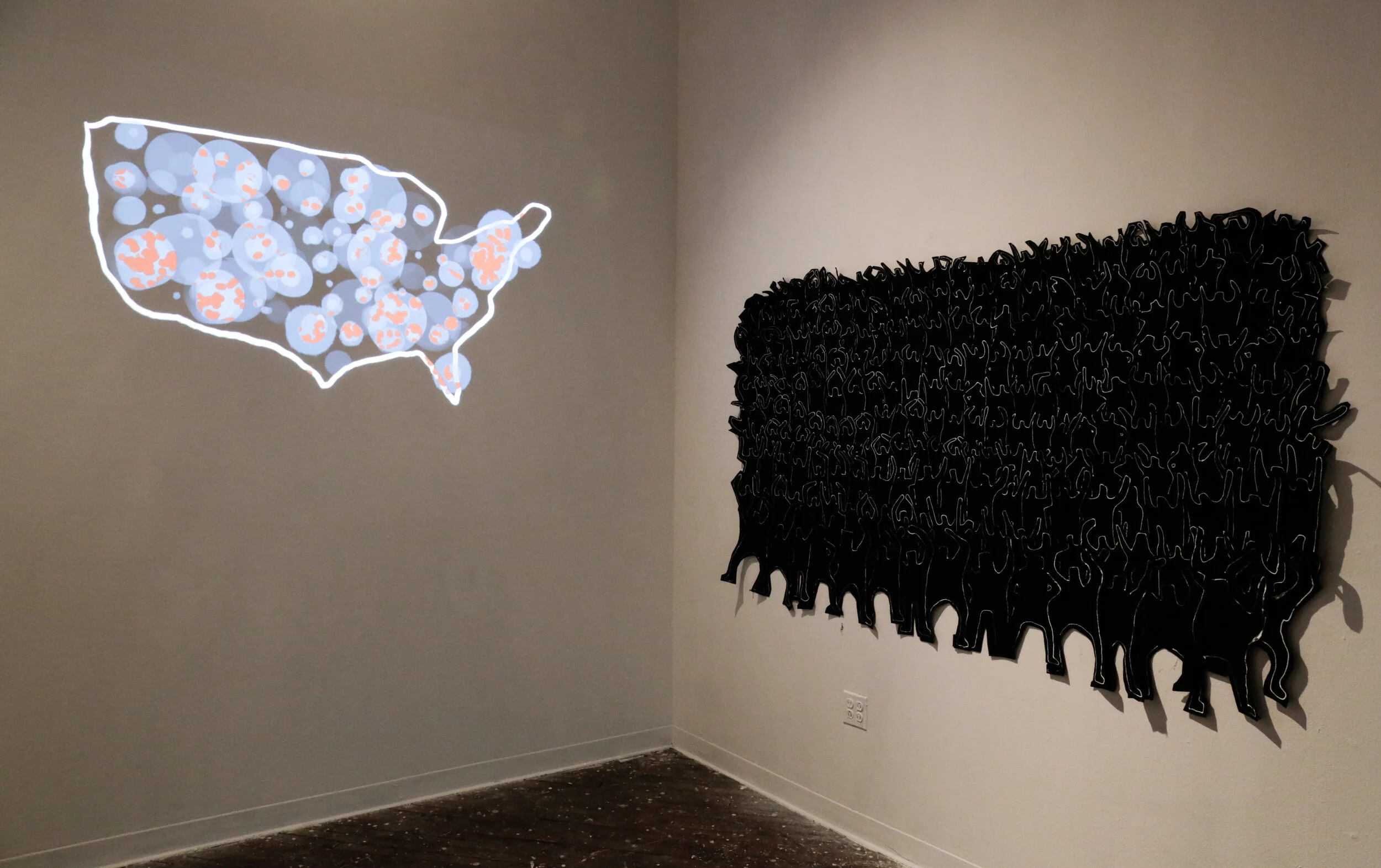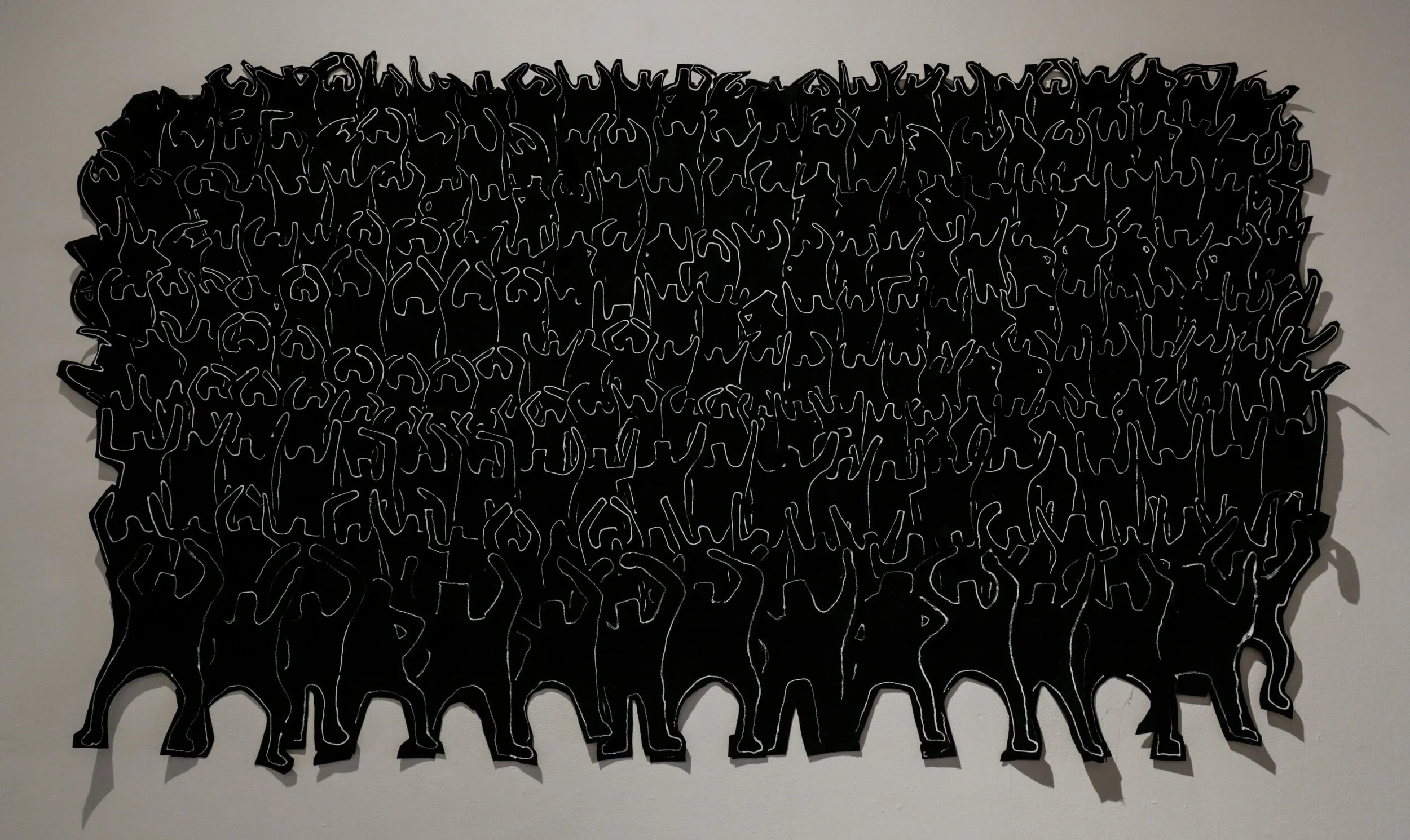Hindsight 2020: Roksana Filipowska on Jennie Thwing’s Exhibit, 2020
Jennie Thwing’s solo exhibit at Grizzly Grizzly was one of only a handfull of shows we presented in a year cut short by the COVID-19 pandemic. Thwing’s personal perspective on the Trump era, Black Lives Matter, the pandemic, and the twenty-four-hour news stream become a rhythmic mantra in her video installation and a response to the extraordinary turmoil of this pivotal year. Roksana Filipowska’s essay extends “a small gesture of appreciation, in hindsight, for artists like Thwing, who gave form to the nebulous and for the exhibitions still waiting for their audiences.”
2020/21 Grizzly Grizzly programming and residencies are supported by Added Velocity which is administered by Temple Contemporary at Tyler School of Art and Architecture, Temple University and funded by the William Penn Foundation.
2020, video installation including a cell animation and 2-8’ x 4'’ felt and canvas wall hangings.
The month of March marks an end and a beginning. The Gregorian calendar designates January 1st as the start of a year, yet it is the spring equinox, which occurs around March 20th in the Northern Hemisphere that holds both the conclusion of winter and the arrival of spring. Such is the rhythm of natural cycles: endings lead to beginnings, which in turn run their course and give way to the new. This year, March also marks the one-year anniversary of the Covid-19 pandemic in the United States. The virus had raged for months across China and brought Italy under lockdown before the term “Covid-19” became commonly known in the US. This disturbance within the mesh of our global coexistence should have sounded an alarm, but, tragically, the entrance of the virus into our lives and vocabulary was met with misinformation and xenophobia rather than action and unity from the federal government. It’s difficult to process the passage of a year when the virus is still so present, and because its impact is palpable through the loss of loved ones and mourning for what could have been. This anniversary underscores that the cycle that we are collectively in is longer that both a calendar year and the rhythm of the seasons. The pandemic stretches beyond 365 days because it is compounded by the epidemic of racism and the myth of individualism.
Artists have long shown that timescales can blur, overlap, and entangle. Artworks often are—or inevitably become—palimpsests of biography, allegory, psychology, history, and ecology. Jennie Thwing’s solo show, titled 2020, continues to be a touchstone for me as I feel through the year that spills past the brim of its container, its amorphousness punctuated by the phrase, “what is time?” A delayed essay on an exhibit already taken down, this text is a small gesture of appreciation, in hindsight, for artists like Thwing, who gave form to the nebulous, and for the exhibitions still waiting for their audiences.
I visited Thwing’s solo show in November 2020. I think it was a Friday, a habitual decision and an attempt to reconnect with the monthly ritual of attending exhibition openings at Building 319. Resounding down an empty hallway, the rhythmic soundtrack to Thwing’s titular animated video announced the show well before reaching the door of Grizzly Grizzly and seeing the installation. It was uncanny to walk past the entrances to Napoleon, Automat, and other spaces without brushing shoulders in that so-often cramped corridor. Thwing’s animation is accessible through Grizzly Grizzly’s website but the virtual experience doesn’t quite reflect encountering the work in person: the soundtrack is loud, and it’s near impossible not to move along to its pulsing dance beat. Thwing created the soundtrack by layering audio files and sound bites readily available through Free Sound, an open source and collaborative database, to combine indexes of found sounds, such as recordings of flowing water, with synthesized notes into a lively soundscape of the creative commons. The soundtrack is a sonic seduction and a call-to-participation for anyone who moves through that hallway.
Whereas Thwing’s soundtrack seems to evoke a shared and egalitarian—perhaps even utopian—future, the animation captures the juxtaposition of trauma and hope of the present. Thwing’s work is populated, but not by individuals; Her animation features groups, and sometimes masses, of anonymous figures. Drawn in stark white outline, the figures evoke Keith Haring’s iconic bodies though, whereas Haring relished in the erotics of male genitals, Thwing’s bodies are androgynous. Performing a range of gestures, Thwing’s bodies stomp to evoke dance, freeze, mime the delivery of a news broadcast, and cough. Despite using a limited color palette of black, white, blue, and red, Thwing references the numerous forces that impacted bodies in 2020, including police brutality, the spread of Covid-19, and bipartisan politics. Thwing’s dancing figures appear alongside references to the Black Lives Matter movement and the dance beat of the soundtrack, suggesting the liberatory potential of disbanding white supremacy through joyful and unified action. In a later motif, which is a sharp contrast to the dancing figures, a single casket multiples exponentially to fill the entire screen as a grid of coffins. It is hard to experience these two scenes in such close proximity, yet this continues to be the reality of the pandemic. Bodies are vulnerable and responsive vessels. They may move to music, embody ideals and ideology, carry the virus, and yield to illness—as far too many have.
Approaching the body as a site of resistance, oppression, and liberation, Thwing’s 2020 is an installation for processing the both/and experience of being an embodied being within a shared and troubled world. In the Gallery, the video 2020 is accompanied by two felt sculptures, which hang on opposite sides of the gallery to frame the animation. Each of the two sculptures consist of numerous individual black felt figures that are attached together to form a rectangular mass, evoking the outline of mainland United States. Appearing as both figure and ground, black felt adds a sense of warmth and insulation, as well as a tactile element, to Thwing’s animated work. The sculptures are also a record of Thwing’s process: she cut each figure individually out of soft sheets of felt to create her animation. These figures are therefore also “felt bodies,” or bodies that were once touched by Thwing. Anonymous and androgynous, the bodies are formed through—and also embody—tenderness and care. Regardless of the role, or roles, they play within the video, they appear still, and resting, within the sculptures.
Generously, Thwing built in time for reflection throughout the exhibition. There is a vignette of swimmers in the video 2020 in addition to the sculptures of resting felt bodies. Accompanied by a soundtrack of flowing water that evokes a bubbling brook, an animation of swimming bodies offers a moment of pause, as well as a sense of buoyancy and restoration. Thwing’s video work plays on a loop, but it is so rich in sonic and visual layering that I found myself focusing on different details with each viewing. Unaccompanied by a dance beat or the uneasy beeping of heart monitors, the vignette of swimmers seemed to expand in duration beyond its allocated frame. With time, the loop of 2020 became spiralic, as though rest could guide the way out of a cycle of trauma and open on to healing. So too, artworks that invite viewers to face, and feel, the multiple traumas and reckonings of 2020 will continue to offer moments of reflection, and processing, for many calendar years and cycles of the seasons.
Roksana Filipowska, Ph.D., is a curator, researcher, and educator interested in the intersections of art and science. She is the Wurtele Study Center Programs and Outreach Manager at the Yale University Art Gallery and a member of Grizzly Grizzly.
Jenny Thwing received her BFA from Tyler School of Art and her MFA from the University of Maryland Baltimore County. She teaches time-based media at SUNY Farmingdale State College. She has had solo exhibitions at Grizzly Grizzly, Local Project, Chashama Space to Present, the Arlington Arts Center, the Center for Emerging Visual Artists, the Pittsburgh Center for the Arts, The Mainline Art Center, Soho 20 Gallery, School 33, Fleisher Art Memorial Dene M. Locheim Gallery, Nexus Foundation for Today’s Art, Studio 34 and 20.20. She has curated numerous multidisciplinary exhibitions and attended residencies in the US, Norway, New Zealand, and Canada. She has received numerous awards including the 2014 Meyer Family Award for Contemporary Art; an Environmental Art Project Grant at the Schuylkill Center; a 2013 - 15’ Center for Emerging Artists Fellowship; a 2014 SPARC Artist in Residence grant; and a 2014 & 2019 Queens Arts Fund Grant.




